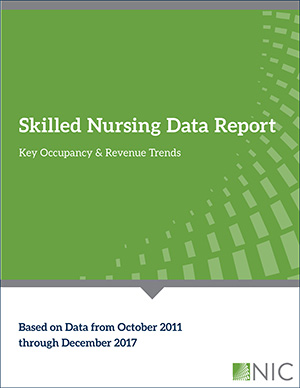– Urban vs. rural occupancy trends diverge
– Medicaid revenue mix nearly 50%
NIC has just released its fourth quarter 2017 Skilled Nursing Data Report, which now includes urban vs. rural trends, along with revenue mix by payor source. In addition to key monthly data on skilled nursing metrics, it includes time-series data from October 2011 through December 2017.
The current report is based on data collected monthly, but reported quarterly, from approximately 20 operators and 1,500 properties. The data represents national, aggregate figures. However, NIC plans to grow the data set, adding more operators and properties to produce state-level reports. NIC welcomes the participation of operators nationwide in this confidential data collection process. Participants will receive a free benchmark report every month for their contribution.
Here are some key takeaways from the report:
- Occupancy continued to decrease in the fourth quarter of 2017 despite an early and severe flu season. Historically, there has been an uptick in occupancy in the fourth quarter if flu season was both early and relatively severe, as it was the case this year. Occupancy decreased 66 basis points from the third quarter of 2017 to end the fourth quarter at 81.9%. Compared to a year ago, occupancy declined 159 basis points from 83.5% in the fourth quarter of 2016.
- Differences in occupancy trends in rural and urban settings were pronounced over the last 12 months, with rural occupancy rates declining more sharply than urban. This may reflect many differences including demographics, competition from home healthcare and telehealth, and reforms to the healthcare system. With the introduction of this new geographic perspective on NIC’s skilled nursing data, more research is needed to shed light on the drivers of occupancy in the rural and urban sectors.
- Managed Medicare revenue per patient day (RPPD) pressures were again evident in the latest data as it reached a new low at $433. However, an analysis of urban vs. rural areas suggests that the pressures of managed Medicare are more prevalent in urban areas than rural areas, as the managed Medicare patient day mix currently stands at 7.3% in urban areas and only 2.7% in rural areas. In addition, managed Medicare patient day mix in rural areas has essentially been flat over the past 6.25 years ranging from 2.5% to 2.7%, whereas it grew from 5.8% to 7.3% in urban areas in the same period.
- Medicaid revenue mix now represents essentially half of all revenue at skilled nursing properties at 49.3% as of the fourth quarter of 2017. That percentage is up 70 basis points from the prior year in the fourth quarter of 2016. Meanwhile, revenue mix has decreased for Medicare, the highest payor, to 22.8% which is down 98 basis points from the prior year. This trend presents a challenge to the traditional skilled nursing business model as Medicaid, the lowest payor, is growing in revenue mix as the highest payor, Medicare, is decreasing in revenue mix.
- Private patient day mix is significantly higher in rural areas when compared to urban areas. Rural private patient day mix is now 15.6% as of the fourth quarter of 2017 compared to only 6.5% in urban areas. One possible explanation for the differences among geography types is that urban skilled nursing properties may face higher competition for market share, in part because of a greater supply of similar products such as home care and other seniors housing types.
- A comparatively higher private patient day mix over the years and a significantly higher increase in private revenue per patient day, along with less exposure to the pressures of managed Medicare, are the main drivers of rural areas showing a slight increase in the overall weighted average revenue per patient day across payor types over the past 6.25 years. However, higher expense growth, especially wage rate growth over the years, needs to be factored in when assessing the overall profit of the business.
NIC released its latest Skilled Nursing Data Report on March 7, 2018. You can download the latest report and future reports here.
